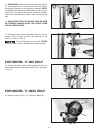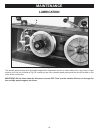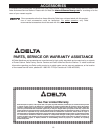
14
VARIABLE SPEED CONTROL
DO NOT turn variable speed pilot wheel handles (A) Fig.
28, unless motor is running to avoid putting unnecessary
strain on the drive belts and pulleys. The pilot wheel
handles (A) are turned clockwise to increase speed and
counterclockwise to decrease speed. When changing
speeds, the pointer (B) will indicate the speed of the drill
press.
Fig. 28
A
A
B
SPEED RANGE CONTROL
The speed range control lever (A) Fig. 29, MUST NOT
be moved except when the motor is running. When the
handle (A) is in the up “HIGH” position, the speed range
is 500 to 3200 RPM; and when the handle (A) is in the
“LOW” position, the speed range is 150 and 1100 RPM.
Fig. 29
A
Fig. 30
D
DRILLING HOLES TO DEPTH
When a number of holes are to be drilled to exactly the
same depth, the stop nut (A) Fig. 30, on the threaded
stop rod (B) is used as follows:
1. Lower the chuck (C) Fig. 30, and drill bit to the depth
you wish the drill bit to be by rotating the pinion shaft
handles (D). Then lock the quill in position by tightening
quill locking lever (E). NOTE: Quill locking lever (E) is
spring-loaded and can be repositioned by pulling out on
the handle and repositioning the hub of the handle on
the nut located underneath the hub.
2. Depress spring-loaded button (F) Fig. 30, and rapidly
move stop nut (A) until bottom of nut (A) contacts stop
(G). While holding the pinion shaft handle (D) Fig. 30,
loosen the quill locking lever (E), allow the chuck (C) and
the quill, to return to the up position by gradually
allowing the pinon shaft handles to rotate to the up
position.
3. Drill a test hole to check the adjustment and readjust
if necessary by rotating stop nut (A) Fig. 30, for fine ad-
justment. It is not necessary to depress button (F) while
rotating stop nut (A) for fine adjustment.
C
E
F
A
G
B


















